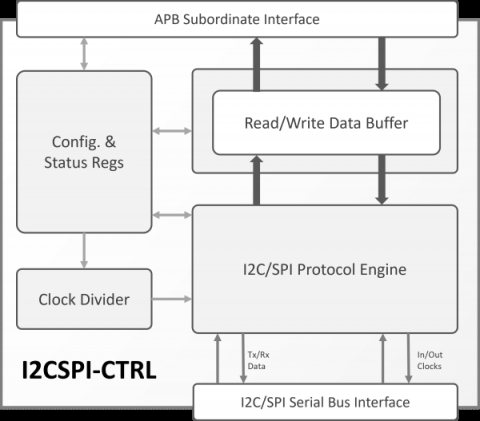You are here:

I2C and SPI Master/Slave Controller
The I2CSPI-CTRL is a compact and versatile serial interface controller supporting both SPI (Serial Peripheral Interface) and I2C (Inter-Integrated Circuit) protocols. Its low silicon resource requirement makes it suitable for area-constrained and low-power applications, while its software compatibility with Microchip’s MSSP peripheral eases use and software integration.
In SPI mode, the I2CSPI-CTRL controller can operate as either a controller (master) or target (slave), offering full-duplex communication. In master mode, it initiates data transfers and controls the clock (SCK), while in slave mode, it operates under the control of an external master device. The I2CSPI-CTRL supports configurable clock polarity and operates in the four standard SPI modes (0, 1, 2, 3).
In I2C mode, the I2CSPI-CTRL supports standard and fast mode with transfer rates of up to 400khz, with both 7-bit and 10-bit addressing. It can function as either a master or a slave, with the capability to manage multiple addressing modes and clock stretching. In master mode, the I2CSPI-CTRL initiates communication, sends addresses, and manages data transfer timing. In slave mode, it responds to addresses sent by an external master, acknowledges reception, and sends data upon request. The I2CSPI-CTRL also supports general call addressing and SMBUS protocols, making it suitable for various applications.
The I2CSPI-CTRL core is designed for ease of use and integration and adheres to the industry’s best coding and verification practices. The core’s control and status registers (CSR) are accessed through a 32-bit AMBA® APB interface. The design contains no latches or tri-states and is fully synchronous with a single clock domain making technology mapping straightforward. The I2CSPI-CTRL core is rigorously verified and silicon-proven. It is available in LINT-clean System Verilog source code or as a targeted FPGA netlist. Its deliverables include a testbench, comprehensive documentation, and sample simulation and synthesis scripts.
In SPI mode, the I2CSPI-CTRL controller can operate as either a controller (master) or target (slave), offering full-duplex communication. In master mode, it initiates data transfers and controls the clock (SCK), while in slave mode, it operates under the control of an external master device. The I2CSPI-CTRL supports configurable clock polarity and operates in the four standard SPI modes (0, 1, 2, 3).
In I2C mode, the I2CSPI-CTRL supports standard and fast mode with transfer rates of up to 400khz, with both 7-bit and 10-bit addressing. It can function as either a master or a slave, with the capability to manage multiple addressing modes and clock stretching. In master mode, the I2CSPI-CTRL initiates communication, sends addresses, and manages data transfer timing. In slave mode, it responds to addresses sent by an external master, acknowledges reception, and sends data upon request. The I2CSPI-CTRL also supports general call addressing and SMBUS protocols, making it suitable for various applications.
The I2CSPI-CTRL core is designed for ease of use and integration and adheres to the industry’s best coding and verification practices. The core’s control and status registers (CSR) are accessed through a 32-bit AMBA® APB interface. The design contains no latches or tri-states and is fully synchronous with a single clock domain making technology mapping straightforward. The I2CSPI-CTRL core is rigorously verified and silicon-proven. It is available in LINT-clean System Verilog source code or as a targeted FPGA netlist. Its deliverables include a testbench, comprehensive documentation, and sample simulation and synthesis scripts.
查看 I2C and SPI Master/Slave Controller 详细介绍:
- 查看 I2C and SPI Master/Slave Controller 完整数据手册
- 联系 I2C and SPI Master/Slave Controller 供应商
Block Diagram of the I2C and SPI Master/Slave Controller







